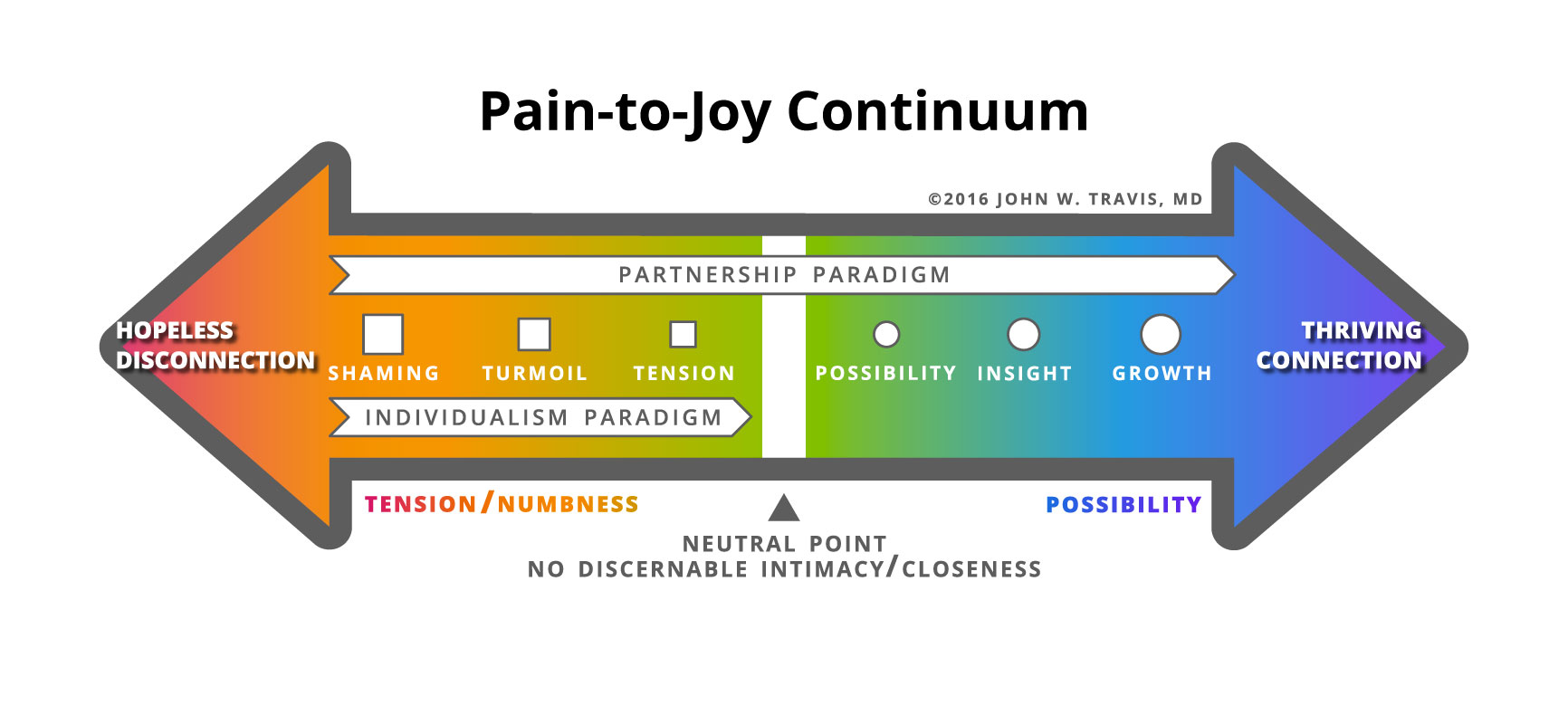Pain-to-Joy Continuum
A Pathway from Disconnection/Hostility to Thriving Connection
Wherever a couple is, there is always room for greater thriving. Over time, both partners grow and change, often in different ways and at different rates. To stay close, couples need to also grow together, which requires tending.
When a baby arrives, ample support is required for such tending. Without it, a partnership can slip closer to the pain side of the Continuum, running the risk of irreparable disconnection.
Dr. John Travis translates his original Illness-to-Wellness Continuum into a relationship connection continuum from Pain-to-Joy, reflecting his belief “the currency of wellness is connection.” This continuum is particularly geared toward the wellness of couples in committed relationships.
- Hopeless Disconnection (Relentless Hostility; Isolation Separation (lead to depression, sadness)
- Shaming and Blaming (Contempt Irresponsible, Fighting, Aggressive)
- Turmoil/Resignation
- Tension/Numbness
- Neutral Point (No discernible intimacy/closeness), Indifference/Apathy
- Possibility
- Insight
- Growth
- Thriving Connection
Opposite of love isn’t hate, it’s abandonment.
Most of us think of relationship in terms of functionality. We assume that the absence of dysfunction or pain indicates relationship wellness. There are actually many degrees of relationship wellness, just as there are many degrees of dysfunction and pain. The Relationship Pain to Joy Continuum illustrates the differences between the Treatment Paradigm (reducing dysfunction) to the wellness paradigm (increasing joy).
Moving from the center to the left on the Continuum shows a progressively worsening degree of dysfunction and pain. Moving to the right of center indicates increasing levels of joy and wellbeing. The Treatment Paradigm (counseling, psychotherapy, mood changing drugs, etc.) can bring a relationship up to the neutral point where the dysfunction has been alleviated. The Wellness Paradigm, which can be utilized at any point on the Continuum, helps a couple move toward higher levels of joy and wellness.
Couples often lack awareness of their relationship’s dysfunction. Fathers especially, due to cultural male proscriptions against acknowledging feelings, may be unaware of having old childhood/birth wounds reactivated by the birth of their child. As a result, they often self-medicate to suppress the pain of abandonment, anxiety, or depression. They may turn to drugs, alcohol, workaholism, combativeness, emotional withdrawal, or affairs. It is here that the Treatment Paradigm can be useful in addressing the stages of dysfunction.
The Wellness Paradigm moves the relationship beyond neutral and encourages a couple to go as far to the right as possible. On the left side of the Continuum, the Wellness Paradigm is not meant to replace the Treatment Paradigm, but rather to work in harmony with it. If a couple is experiencing dysfunction, then treatment is important, but it’s important not to stop at the Neutral Point—they can use the Wellness Paradigm to move toward higher levels of joy and wellness.
Awareness of the Wellness Paradigm as a complement to the Treatment Paradigm, can support a couple in better meeting their basic human needs for acknowledgement, respect, a stimulating and supportive environment, and a sense of purpose and meaning as a couple. This process of co-evolution can deepen a relationship, resulting in higher levels of joy and wellbeing.

